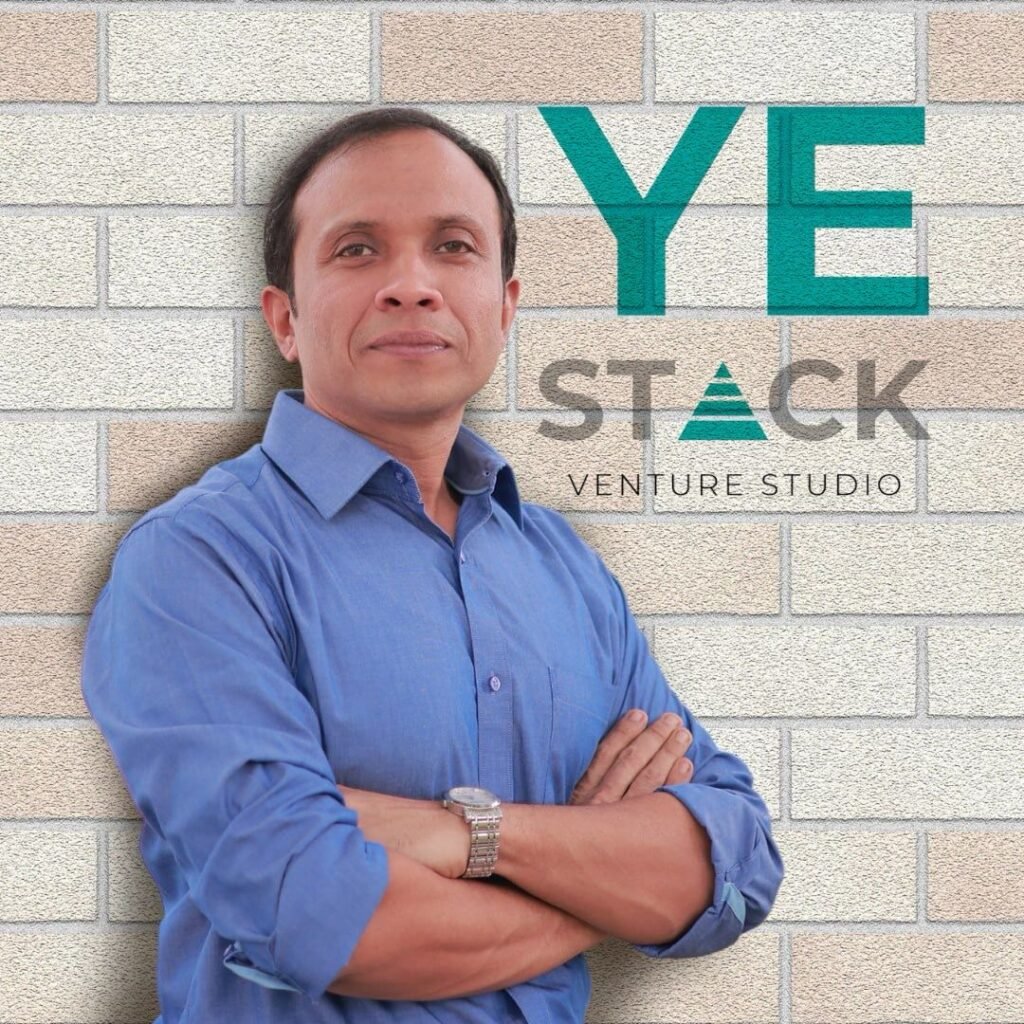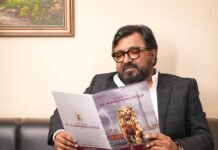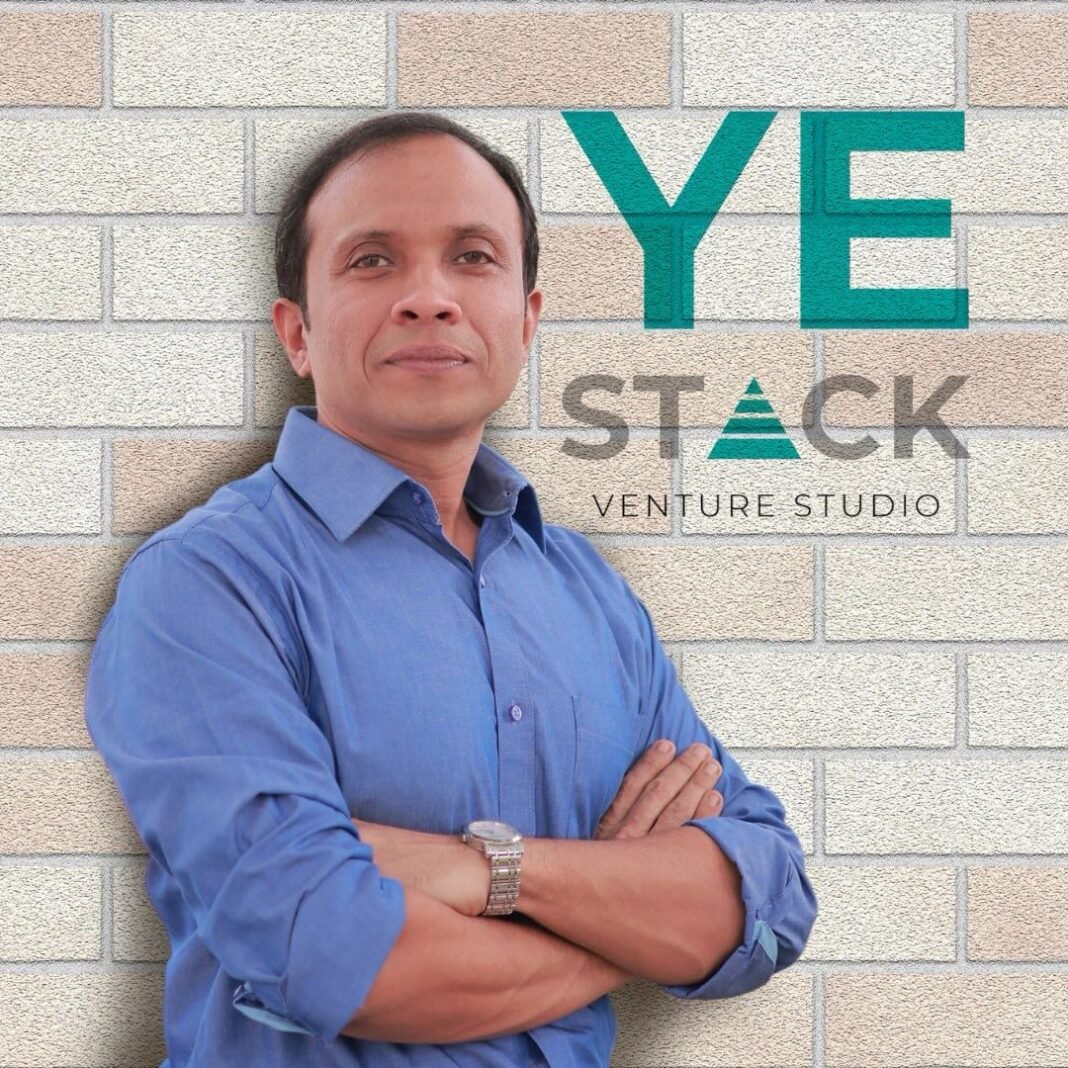
1. What inspired you to transition from being an entrepreneur to a venture builder? What unique perspectives do you bring from your entrepreneurial experience to YE Stack?
In my view, there’s no real transition from entrepreneur to venture builder; the scope and depth of activities change. As a venture studio founder, I continue to build ventures, applying insights gained from 15 years of entrepreneurial experience. This background allows me to offer a broader perspective, advising on the best approaches based on repeated experiences.
As a venture builder, I leverage my extensive experience to guide multiple startups, providing valuable advice on handling various dimensions of the entrepreneurial journey. Typically, only serial entrepreneurs venture into building studios due to the depth of perspective required. YE Stack is my endeavor to partner with co-founders and startups, bringing a decade of insights and capabilities to the table, and helping them navigate their startup journeys more effectively.
YE Stack represents my vision of venture building, where I partner with co-founders and startups to apply this accumulated knowledge. The goal is to channel years of entrepreneurial experience into a structured approach that supports new ventures, helping them navigate the complexities of scaling and achieving success.
2. How did the idea for YE Stack originate? What were the initial challenges you faced in establishing the venture studio model in India?
The idea for YE Stack emerged from my own entrepreneurial journey of about 15 years ago. Initially, as a first-time entrepreneur, I encountered numerous unforeseen challenges and struggled for years to pinpoint the root causes. This experience made me realize that many difficulties stemmed from both personal limitations and external factors. I believed there had to be a more effective way for new entrepreneurs to navigate these challenges. This belief led me to mentor young entrepreneurs, which gradually evolved into a vibrant community focused on peer learning and shared experiences.
After seven years of fostering this community, it became clear that there was value in offering a structured solution to early-stage entrepreneurs. This led to the creation of YE Stack as a venture studio, designed to provide a comprehensive set of learnings and support based on our collective experiences. The venture studio model we developed aims to deliver this accumulated knowledge in a way that can significantly enhance the entrepreneurial journey for new founders.
Establishing YE Stack in India presented significant challenges, primarily due to a lack of awareness about the venture studio model. Many people confuse it with incubators and accelerators, and skepticism remains high due to the model’s novelty in the country. This has required substantial effort in educating stakeholders and demonstrating the unique benefits of the venture studio approach. Despite these hurdles, we are committed to advocating for the model and building a robust ecosystem to support and scale startups effectively in India.
3. As a leader, how do you foster a culture of innovation and risk-taking within YE Stack? What role does mentorship play in your leadership style?
Mentoring is one dimension of leadership, which has many layers. There are authoritarian, visionary, ideology-based, and transformative leadership styles. Coaching or mentoring is part of transformative leadership, where you work on transforming the people you work with.
Every leader would have elements of all these styles, but there’s usually an anchor. Mine happens to be mentoring or coaching, as my primary anchor is transformative. Leadership is about taking a person from where they are to a place they couldn’t imagine. This involves working on their mental models.
To do this, you must build trust, understand the person in depth, show them their limitations, potential future, and give them trust to join your journey. Mentorship provides a structured mechanism for this. I’ve been lucky to do this daily for about eight years, continuously learning from what went right and wrong.
Regarding fostering a culture of innovation and risk-taking, it’s even more challenging. The whole pursuit is about creating an environment with psychological safety. Without it, people won’t take even calculated risks due to fear of ridicule or failure.
You create a high-trust environment where people feel safe to be themselves. This is typically done through a community mechanism with shared values and beliefs. When people understand what behaviors are encouraged, it leads them to take risks.
4. How is YE Stack redefining the traditional venture capital model? What impact do you envision YE Stack having on the Indian startup ecosystem?
YE Stack is not intending to redefine the venture capital ecosystem. That’s not our objective. YE Stack is a venture studio, while venture capital is a type of capital that takes relatively higher levels of risk to generate superior returns. These are not competing models but exist side by side.
Venture studios bring a collaborative playbook to build startups. YE Stack is one such venture studio where an aspiring founder gets a mechanism to build faster and better through assembled capabilities.
Regarding the impact on the Indian startup ecosystem, we’re seeing multiple startup ecosystems being built across the country. The venture studio format allows first-time or second-time founders to work with more experienced founders who bring clarity in pursuit and design, and capabilities to build startups faster.
The impact of such ecosystems is yet to be fully seen in India, as current ecosystems mostly provide early-stage risk capital. Venture studios bring more capabilities beyond just capital availability.
How founders leverage these capabilities will determine how this ecosystem develops over the next decade. As more founders use venture studios and share their experiences, newer generations of founders will become familiar with the model.
Misconceptions will dissipate, and founders will understand it’s a worthwhile model to consider, especially in the early phases of their entrepreneurship journey. The more founders we attract, the more their stories will demonstrate the value of the venture studio model.
5. With a global outlook, what are YE Stack’s plans for expansion into new markets? How do you plan to adapt your model to different regional ecosystems?
India, with its demographic advantages, is increasingly seen as a primary source of talent capital for industries and startups worldwide. YE Stack, being anchored in India, has a potential value-creating cog that can be leveraged by startups building elsewhere in the world.
We created an initiative to see if a venture studio from India could offer significant leverage to global founders. We’ve been experimenting over the last few months and received encouraging feedback from founders across the globe, especially from developed markets in the US, Europe, and Australia. They found this model enabling, and some have started building companies with YE Stack’s help from India.
This model involves a venture studio based in India, where talent availability is going to be a significant driver of value creation over the next decade. Having a team based in India and capabilities built for startups from India allows these founders to build and expand their teams as they grow.
Founders who appreciate this principle are likely to consider this approach more, as the right time to build a cog for your startup in India is when you start, not after you’ve grown. It requires strategic thinking of that order. Some founders have already started doing this, and we’re happy to collaborate with them.
6. What is your vision for global expansion? Are there specific regions or industries where you see significant growth potential?
We’re too early to comment definitively about global expansion or the value pillars we’ll pursue. We’re currently in a phase of discovering our sources of power and leverage that we can offer to global founders. We’re building our capabilities one by one.
While building our own startups, we’re trying to identify which of these capabilities prove valuable to global founders. We’re offering them sequentially to see what is found to be most valuable. We’ve started offering technical capabilities, product building capabilities, innovation capabilities, and design capabilities. We’re experimenting with these one after another.
Over time, we’ll identify a set of things that global founders find particularly attractive to leverage from YE Stack. Until we find that, we can’t really discuss making it our anchor because we don’t know yet. We’re in an experimentation phase to determine the most valuable leverage a global founder can get from YE Stack.
Once we prove our hypothesis and understand what’s most valuable, then we can make more concrete plans. For now, we’re focused on testing and validating our offerings to global founders.
7. Beyond financial returns, how does YE Stack measure the success of its portfolio companies? What are the key metrics you track to assess the overall performance of the venture studio?
Venture studios typically specialize in taking a bird’s eye view of how to build a startup. This translates to designing the startup you intend to build. We focus on whether you’ve designed each element of a startup, and whether the design has been implemented.
When measuring success beyond financial metrics, we consider several aspects. First, we assess design implementation through people, evaluating whether the design has been implemented effectively. Second, we look at capability building. We clearly see what capabilities the startup has assembled, what’s missing, what requires support, and what the founding team excels at. The venture studio tries to plug those capability gaps.
The third element is designing a system to track execution, ensuring people understand the sense of progress and momentum created over time. Financial metrics are definitely one dimension, providing clear feedback on paying customers. However, prior to gaining customers, we focus on multiple leading indicators that can be designed to eventually lead to revenue.
Venture studios typically decide on the right type of leading indicators. Some are related to people, some to market outreach, and some to traction created in particular channels. This approach is possible because, unlike first-time founders, venture studios typically have exposure to multiple startups being built in parallel across various domains. This allows us to create and execute a playbook that can be tracked effectively.
8. How do you see the venture studio model evolving in the next few years? What challenges and opportunities do you anticipate?
Venture studios are in a very sweet spot due to the many changes happening around us. For example, artificial intelligence has enabled founders to launch startups much faster and more effectively. Globally, the timeline for building a startup is shrinking from three to five to ten years, as people look for ways to accelerate the process. Given the uncertainty about the market’s future, founders are increasingly interested in assembling capabilities that enhance their zero-to-one journey.
Once the model becomes attractive, it will be difficult for founders to justify going it alone when they can access a comprehensive set of capabilities from a venture studio. As venture studios accelerate startup development, founders will find them increasingly appealing. This trend, fueled by advancements like AI, will likely lead to the growth of venture studios worldwide, creating more opportunities for this model.
9. Given your experience in the Indian startup ecosystem, what are the key trends and challenges that Indian startups face today? How is YEstack addressing these challenges?
Every founder has a point of view, which is like a thesis they are trying to establish through a startup. It could be aimed at solving a specific problem. In the case of our venture studio, YE Stack focuses on solving the problems faced by early-stage founders. The primary premise is that there are unsolved challenges for early-stage founders. While the current ecosystem provides substantial support and enabling activities, it still leaves early-stage founders at a disadvantage. The focus is on early-stage founders because the ecosystem improves significantly as you move from one to ten or ten to a hundred stages.
In the zero-to-one stage, the amount of founder talent and opportunities being missed is high due to the lack of proper guidance and support for first-time or aspiring entrepreneurs. Vicetack aims to address this gap by providing various formats of support for founders, including capability enhancement, advisory services, and strategic guidance. The objective is to give founders clear direction on what needs to be done, allowing them to validate their ideas as quickly as possible. With these capabilities, founders can decide at each stage whether they are ready to proceed to the next stage.
Mechanisms that focus on solving the most valuable problems for founders at each stage are not readily available to early-stage founders. YE Stack aims to make a significant difference by addressing this gap and helping founders tackle the most critical challenges in their zero-to-one journey.































